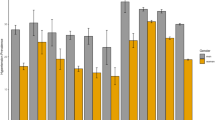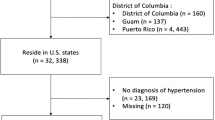Abstract
Although a health advantage in hypertension has been documented among Latinos, this advantage appears to be eroding. Of particular concern is the observation that Latinos are less likely to be screened and treated for hypertension and to having it controlled. Scholars have suggested that, above and beyond individual-level factors, neighborhood characteristics may be important predictors of health and health care. We analyzed 2001–2003 data from the Chicago Community Adult Health Study to examine (a) the relationship between the Latino and immigrant composition of neighborhoods in Chicago and several outcomes among Latinos: having hypertension, utilizing hypertension-related health care, and being treated for hypertension; and (b) whether there was a differential effect of neighborhood Latino/immigrant concentration by language of interview and nativity status. We controlled for additional neighborhood characteristics relevant to hypertension and to the availability and accessibility of health care resources. Neighborhoods with higher concentrations of immigrants and Latinos were associated with Latinos having lower odds of hypertension (OR = 0.60, p = 0.03). However, among those with hypertension, our results point to deleterious effects on hypertension care (OR = 0.55, p = 0.06) and treatment (OR = 0.54, p = 0.04) associated with living in neighborhoods with higher concentrations of immigrants and Latinos. We detected no significant interaction effects between immigrant/Latino neighborhood composition and language of interview or being an immigrant in this sample. These results suggest that improving access to care for Latinos with hypertension requires enhanced placement of community clinics and other safety-net health centers in neighborhoods with higher proportions of immigrants and Latinos.
Similar content being viewed by others
References
Centers for Disease Control and Prevention. Health disparities experienced by Hispanics—United States. MMWR. 2004;53(40):935–7.
Escarce JJ, Morales LS, Rumbaut RG. The health status and health behaviors of Hispanics. In: Tienda M, Mitchell F, editors. Hispanics and the future of America. Washington, DC: The National Academies Press; 2006. p. 362–409.
Vega WA, Amaro H. Latino outlook: good health, uncertain prognosis. Annu Rev Public Health. 1994;15:39–67.
Vega WA, Rodriguez MA, Gruskin E. Health disparities in the Latino population. Epidemiol Rev. 2009;31(1):99–112.
Perez-Stable EJ, Salazar R. Issues in achieving compliance with antihypertensive treatment in the Latino population. Clin Cornerstone. 2004;6(3):49–64.
Ong KL, Cheung BMY, Man YB, Lau CP, Lam KSL. Prevalence, awareness, treatment, and control of hypertension among United States adults 1999–2004. Hypertension. 2007;49(1):69–75.
Keenan NL, Rosendorf KA. Prevalence of hypertension and controlled hypertension—United states, 2005–2008. MMWR. 2011;60(Suppl):94–7.
Winkleby M, Kraemer HC, Ahn D, Varady AN. Ethnic and socioeconomic differences in cardiovascular disease risk factors: findings for women from the third National Health and Nutrition Examination Survey, 1988–1994. JAMA. 1998;280:356–62.
Bersamin A, Stafford R, Winkleby M. Predictors of hypertension awareness, treatment, and control among Mexican American women and men. J Gen Intern Med. 2009;24:521–7.
Egan BM. US trends in prevalence, awareness, treatment, and control of hypertension, 1988–2008. JAMA. 2010;303(20):2043–50.
Hajjar I, Kotchen TA. Trends in prevalence, awareness, treatment, and control of hypertension in the United States, 1988–2000. JAMA. 2003;290(2):199–206.
Alegría M, Zhun C, McGuire TG, Ojeda VD, Sribney B, Woo M, et al. Health insurance coverage for vulnerable populations: contrasting Asian Americans and Latinos in the United States. Inq J Health Care. 2006;43(3):231–54.
Weinick RM, Zuvekas SH, Cohen JW. Racial and ethnic differences in access to and use of health care services, 1977 to 1996. Med Care Res Rev. 2000;57(3):36–54.
U.S. Department of Health and Human Services. National healthcare disparities report 2008. Rockville, MD: Agency for Healthcare Research and Quality; 2009.
Livingston G, Minushkin S, Cohn D. Hispanics and health care in the United States: access, information and knowledge. Washington, DC: Pew Hispanic Center and Robert Wood Johnson Foundation Research Report; 2008.
Pickett KE, Pearl M. Multilevel analyses of neighbourhood socioeconomic context and health outcomes: a critical review. J Epidemiol Community Health. 2001;55(2):111–22.
Macintyre S, Ellaway A, Cummins S. Place effects on health: how can we conceptualise, operationalise and measure them? Soc Sci Med. 2002;55(1):125–39.
Williams DR, Collins C. Racial residential segregation: a fundamental cause of racial disparities in health. Public Health Rep. 2001;116(5):404–17.
Echeverria S, Diez Roux AV, Shea S, Borrell LN, Jackson S. Association of neighborhood problems and social cohesion with health-related behaviors and depression in the Multiethnic Study of Atherosclerosis (MESA). Health. 2008;14:853–65.
Mair C, Roux AV, Galea S. Are neighborhood characteristics associated with depressive symptoms? A review of evidence. J Epidemiol Community Health. 2008;62:940–6.
Acevedo-García D, Lochner KA, Osypuk TL, Subramanian SV. Future directions in residential segregation and health research: a multilevel approach. Am J Public Health. 2003;93(2):215–21.
Acevedo-Garcia D. Residential segregation and the epidemiology of infectious diseases. Soc Sci Med. 2000;51:1143–61.
Winkleby M, Sundquist K, Cubbin C. Inequities in CHD incidence and case fatality by neighborhood deprivation. Am J Prev Med. 2007;32(2):97–106.
Gaskin DJ, Price A, Brandon DT, LaVeist TA. Segregation and disparities in health services use. Med Care Res Rev. 2009;66(5):578–89.
Gresenz CR, Rogowski J, Escarce JJ. Community demographics and access to health care among U.S. Hispanics. Health Serv Res. 2009;44(5):1542–62.
Prentice JC. Neighborhood effects on primary care access in Los Angeles. Soc Sci Med. 2006;62(5):1291–303.
Kirby JB, Taliaferro G, Zuvekas SH. Explaining racial and ethnic disparities in health care. Med Care. 2006;44(5):164–72.
Kirby JB, Kaneda T. Neighborhood socioeconomic disadvantage and access to health care. J Health Soc Behav. 2005;46(1):15–31.
Diez Roux AV, Mair C. Neighborhoods and health. Ann NY Acad Sci. 2010;1186:125–45.
Portes A. Social capital: its origins and applications in modern sociology. Annu Rev Sociol. 1998;24(1):1–25.
LeClere FB, Jensen L, Biddlecom AE. Health care utilization, family context, and adaptation among immigrants to the United States. J Health Soc Behav. 1994;35:350–84.
Ponce NA. Wealthier but not healthier: Latino enclave effects on cancer screening. American Public Health Association Annual Meeting; October 28, 2008; San Diego, California; 2008.
Alegría M, Canino G, Shrout PE, Woo M, Duan N, Vila D, et al. Prevalence of mental illness in immigrant and non-immigrant U.S. Latino groups. Am J Psychiatry. 2008;165(3):356–69.
Park Y, Neckerman KM, Quinn J, Weiss C, Rundle A. Place of birth, duration of residence, neighborhood immigrant composition and body mass index in New York City. Int J Behav Nutr Phys Act. 2008;5(19):19.
Osypuk TL, Roux AVD, Hadley C, Kandula NR. Are immigrant enclaves healthy places to live? The multi-ethnic study of atherosclerosis. Soc Sci Med. 2009;69(1):110–20.
Haas JS, Phillips KA, Sonneborn D, McCulloch CE, Baker LC, Kaplan CP, et al. Variation in access to health care for different racial/ethnic groups by the racial/ethnic composition of an individuals’ county of residence. Med Care. 2004;42(7):707–14.
Lee M. Neighborhood residential segregation and mental health: a multilevel analysis on Hispanic Americans in Chicago. Soc Sci Med. 2009;68(11):1975–84.
Portes A, Rumbaut RG. Legacies: the story of the immigrant second generation. Berkeley: University of California Press; 2001.
Osypuk TL, Bates LM, Acevedo-Garcia D. Another Mexican birthweight paradox? The role of residential enclaves and neighborhood poverty in the birthweight of Mexican-origin infants. Soc Sci Med. 2010;70(4):550–60.
Brown ER, Levan R, Ojeda VD, Wyn R. Racial and ethnic disparities in access to health insurance and health care. Los Angeles: UCLA Center for Health Policy Research and The Henry J. Kaiser Family Foundation; 2000.
Fiscella K, Franks P, Doescher MP, Saver BG. Disparities in health care by race, ethnicity, and language among the insured. Med Care. 2002;40(1):52–9.
Pippins JR, Alegría M, Haas JS. Association between language proficiency and the quality of primary care among a national sample of insured Latinos. Med Care. 2007;45(11):1020–5.
Eschbach K, Ostir GV, Patel KV, Markides KS, Goodwin JS. Neighborhood context and mortality among older Mexican Americans: is there a barrio advantage? Am J Public Health. 2004;94(10):1807–12.
Morenoff JD, House JS, Hansen BB, Williams DR, Kaplan GA, Hunte HE. Understanding social disparities in hypertension prevalence, awareness, treatment, and control: the role of neighborhood context. Soc Sci Med. 2007;65(9):1853–66.
Balfour JL, Kaplan GA. Neighborhood environment and loss of physical function in older adults: evidence from the Alameda County Study. Am J Epidemiol. 2002;6(507):515.
Brown ER, Davidson PL, Yu H, Wyn R, Anderson RM, Becerra L, et al. Effects of community factors on access to ambulatory care for lower-income adults in large urban communities. Inq J Health Care. 2004;41(1):39–56.
Cunningham PJ, Ginsburg PB. What accounts for differences in uninsurance rates across communities? Inq J Health Care. 2001;38(1):6–21.
Cunningham PJ, Kemper P. Ability to obtain medical care for the uninsured: how much does it vary across communities? JAMA. 1998;280(10):921–7.
Fossett JW, Perloff JD, Kletke PR, Peterson JA. Medicaid and access to child health care in Chicago. J Health Polit Policy Law. 1992;17(2):273–98.
Jiang HJ, Begun JW. Dynamics of change in local physician supply: an ecological perspective. Soc Sci Med. 2002;54:1525–41.
Wen M, Maloney TN. Latino residential isolation and the risk of obesity in Utah: the role of neighborhood socioeconomic, built-environmental, and subcultural context. J Immigr Minor Health. 2011;13(6):1134–41.
Sampson RJ, Raudenbush SW, Earls F. Neighborhoods and violent crime: a multilevel study of collective efficacy. Science. 1997;277(5328):918–25.
Gee GC, Walsemann KM, Takeuchi DT. English proficiency and language preference: testing the equivalence of two measures. Am J Public Health. 2010;100(3):563–9.
Ponce NA, Chawla N, Babey SH, Gatchell MS, Etzioni DA, Spencer BA, et al. Is there a language divide in pap test use? Med Care. 2006;44(11):998–1004.
He J, Muntner P, Chen J, Roccella EJ, Streiffer RH, Whelton PK. Factors associated with hypertension control in the general population of the United States. Arch Intern Med. 2002;162(9):1051–8.
Hertz RP, Unger AN, Ferrario CM. Diabetes, hypertension, and dyslipidemia in Mexican Americans and non-Hispanic whites. Am J Prev Med. 2006;30(2):103–10.
Chobanian AV, Bakris GL, Black HR, Cushman WC, Green LA, Izzo J, Joseph L, et al. The seventh report of the Joint National Committee on prevention, detection, evaluation, and treatment of high blood pressure: the JNC 7 report. JAMA. 2003;289(19):1–12.
Andersen RM. Revisiting the behavioral model and access to medical care: does it matter? J Health Soc Behav. 1995;36(1):1–10.
Perez D, Sribney W, Rodriguez M. Perceived discrimination and self-reported quality of care among Latinos in the United States. J Gen Intern Med. 2009;24(3):548–54.
Acknowledgments
This project was supported by a grant to E. A. Viruell-Fuentes from the Network for Multicultural Research on Health and Healthcare at the Department of Family Medicine, David Geffen School of Medicine, University of California at Los Angeles, with funding from the Robert Wood Johnson Foundation. N.A. Ponce received support from the National Cancer Institute (grant # K07CA100097). The Chicago Community Adult Health Study data collection was funded by grant #s P50HD38986 and R01HD050467 from the National Institute of Child Health and Human Development. The contents of this article are solely the responsibility of the authors and do not necessarily represent the official views of the NICHHD, NCI, or NIH. We thank Aggie Noah and Bryanna Mantilla for their research assistance.
Author information
Authors and Affiliations
Corresponding author
Rights and permissions
About this article
Cite this article
Viruell-Fuentes, E.A., Ponce, N.A. & Alegría, M. Neighborhood Context and Hypertension Outcomes Among Latinos in Chicago. J Immigrant Minority Health 14, 959–967 (2012). https://doi.org/10.1007/s10903-012-9608-4
Published:
Issue Date:
DOI: https://doi.org/10.1007/s10903-012-9608-4




